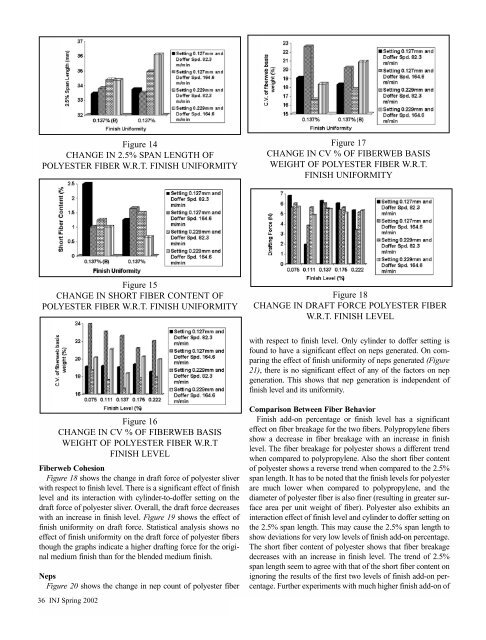2002 - Volume 1 - JEFF. Journal of Engineered Fibers and Fabrics
2002 - Volume 1 - JEFF. Journal of Engineered Fibers and Fabrics
2002 - Volume 1 - JEFF. Journal of Engineered Fibers and Fabrics
You also want an ePaper? Increase the reach of your titles
YUMPU automatically turns print PDFs into web optimized ePapers that Google loves.
Figure 14<br />
CHANGE IN 2.5% SPAN LENGTH OF<br />
POLYESTER FIBER W.R.T. FINISH UNIFORMITY<br />
Figure 15<br />
CHANGE IN SHORT FIBER CONTENT OF<br />
POLYESTER FIBER W.R.T. FINISH UNIFORMITY<br />
Figure 16<br />
CHANGE IN CV % OF FIBERWEB BASIS<br />
WEIGHT OF POLYESTER FIBER W.R.T<br />
FINISH LEVEL<br />
Fiberweb Cohesion<br />
Figure 18 shows the change in draft force <strong>of</strong> polyester sliver<br />
with respect to finish level. There is a significant effect <strong>of</strong> finish<br />
level <strong>and</strong> its interaction with cylinder-to-d<strong>of</strong>fer setting on the<br />
draft force <strong>of</strong> polyester sliver. Overall, the draft force decreases<br />
with an increase in finish level. Figure 19 shows the effect <strong>of</strong><br />
finish uniformity on draft force. Statistical analysis shows no<br />
effect <strong>of</strong> finish uniformity on the draft force <strong>of</strong> polyester fibers<br />
though the graphs indicate a higher drafting force for the original<br />
medium finish than for the blended medium finish.<br />
Neps<br />
Figure 20 shows the change in nep count <strong>of</strong> polyester fiber<br />
36 INJ Spring <strong>2002</strong><br />
Figure 17<br />
CHANGE IN CV % OF FIBERWEB BASIS<br />
WEIGHT OF POLYESTER FIBER W.R.T.<br />
FINISH UNIFORMITY<br />
Figure 18<br />
CHANGE IN DRAFT FORCE POLYESTER FIBER<br />
W.R.T. FINISH LEVEL<br />
with respect to finish level. Only cylinder to d<strong>of</strong>fer setting is<br />
found to have a significant effect on neps generated. On comparing<br />
the effect <strong>of</strong> finish uniformity <strong>of</strong> neps generated (Figure<br />
21), there is no significant effect <strong>of</strong> any <strong>of</strong> the factors on nep<br />
generation. This shows that nep generation is independent <strong>of</strong><br />
finish level <strong>and</strong> its uniformity.<br />
Comparison Between Fiber Behavior<br />
Finish add-on percentage or finish level has a significant<br />
effect on fiber breakage for the two fibers. Polypropylene fibers<br />
show a decrease in fiber breakage with an increase in finish<br />
level. The fiber breakage for polyester shows a different trend<br />
when compared to polypropylene. Also the short fiber content<br />
<strong>of</strong> polyester shows a reverse trend when compared to the 2.5%<br />
span length. It has to be noted that the finish levels for polyester<br />
are much lower when compared to polypropylene, <strong>and</strong> the<br />
diameter <strong>of</strong> polyester fiber is also finer (resulting in greater surface<br />
area per unit weight <strong>of</strong> fiber). Polyester also exhibits an<br />
interaction effect <strong>of</strong> finish level <strong>and</strong> cylinder to d<strong>of</strong>fer setting on<br />
the 2.5% span length. This may cause the 2.5% span length to<br />
show deviations for very low levels <strong>of</strong> finish add-on percentage.<br />
The short fiber content <strong>of</strong> polyester shows that fiber breakage<br />
decreases with an increase in finish level. The trend <strong>of</strong> 2.5%<br />
span length seem to agree with that <strong>of</strong> the short fiber content on<br />
ignoring the results <strong>of</strong> the first two levels <strong>of</strong> finish add-on percentage.<br />
Further experiments with much higher finish add-on <strong>of</strong>

















